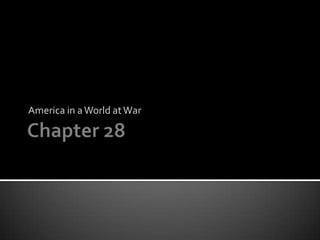
Ch 28: America in a World at War
- 1. America in a World at War
- 2. War on Two Fronts Asia & Europe The American People in Wartime Retreat from Reform Prosperity & Production African-Americans, Native Americans, Mexican Americans, Women & Children, Japanese Americans, and Chinese Americans Defeat of the Axis Liberation of France The Pacific Offensive Atomic Warfare
- 3. What was the relationship like between Italy and France?
- 4. December 7, 1941: Pearl Harbor attacked MacArthur offensive from the South Nimitz offensive from Hawaii June 1942: Battle of Midway; US gains control in the Pacific
- 5. Patton offensive in Africa October 1942: Counter-offensive in Northern Africa Winter 1942 - 1943: Soviets won at Stalingrad July 1943: Patton’s invasion of Sicily
- 6. 1942: News of the Holocaust reached America Genocide of not only Jews but of Romani, Polish and Soviet citizens, homosexuals, the disabled, Jehovah’s Witnesses and political and religious opponents. U.S. resisted military aid The State Department refused to let Jews enter the U.S. St. Louis and its mostly Jewish passengers sailed from Germany to Cuba in 1939; while the US sought to find refuge for the passengers the St. Louis ultimately sailed back to Europe (Belgium)
- 8. Retreat & Reform FDR shifted priorities from reform to the war effort and victory Congress dismantled relief and other New Deal programs 1944 Presidential election saw Roosevelt re- nominated but with a less liberal Vice President Harry Truman
- 9. Prosperity & Production WWII ended the Great Depressions problems of unemployment, deflation, and production 1942: the War Production Board was created to mobilize production By 1944, the U.S.’s output was two times that of all Axis nations combined
- 10. Chinese Americans US allied with China; helped advance Chinese American’s legal and social position 1943: Chinese Exclusion Act repealed Many took jobs in industry or were drafted into the military Japanese Americans Many felt that Japanese-Americans had aided Japan in the Pearl Harbor attacks 1942: Roosevelt created the War Relocation Authority to move Japanese citizens to “relocation camps” for monitoring Korematsu v. U.S. (1944) declared relocation constitutional
- 11. African-Americans Many wanted to use the war to improve conditions A. Philip Randolph sought to integrate the workforce FDR created FEPC; later CORE would combat discrimination using popular resistance Native Americans Some served in the military as “Code Talkers” Some left the reservation for work Mexican Americans Labor shortages saw a large influx of Mexican immigration 1943: “Zoot-suit riots” in Los Angeles
- 12. Women & Children Women began to work in factories as men wen to war; inequalities still existed Some worked in the service sector, others worked in heavy industry Over 1/3 of teenagers began to work
- 13. Liberation of France 1944: Allies bombed Germans; reduced their production and complicated their transportation June 6, 1944: Eisenhower ordered invasion of Normandy (D-Day) May 8, 1945: Germans fully surrendered (V-E Day) The Pacific Offensive June 1944: US defeated Japanese navy The Japanese continued to fight in February 1945 (Iwo Jima) and in June 1945 (Okinawa)
- 14. Atomic Warfare Manhattan Project: the discovery of uranium radioactivity by Enrico Fermi in the 1930s and the evacuated Jewish physicist Albert Einstein’s theory of relativity helped America beat the Nazis in the race to create an atomic weapon July 16, 1945: the plutonium bomb Trinity created by Robert Oppenheimer was successfully tested President Truman issued an ultimatum for Japanese “unconditional surrender” by August 3 August 6, 1945: Hiroshima; 80,000 killed August 8, 1945: Nagasaki; 100,000 were killed September 2, 1945 Japan surrendered (V-J Day); end of WWII
Editor's Notes
- YouTube video: Battle of Midway: The American Counterattack (5:11)
- YouTube video: Japanese Internment during WWII (14:31)